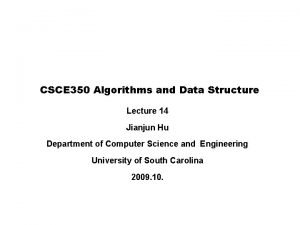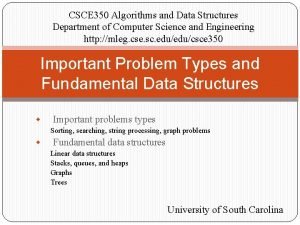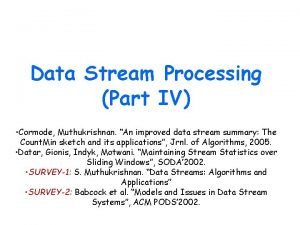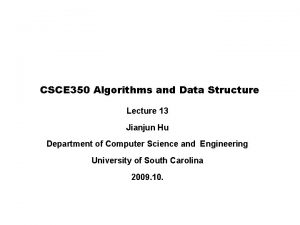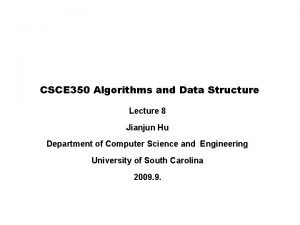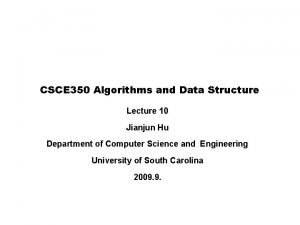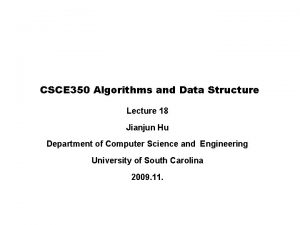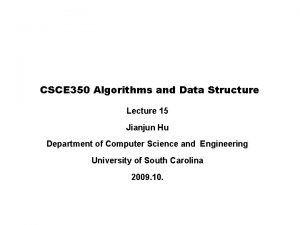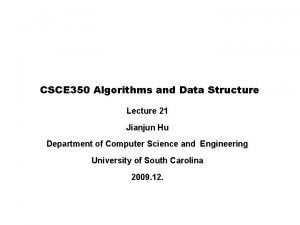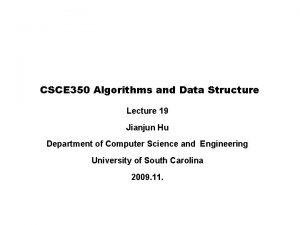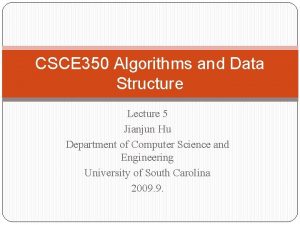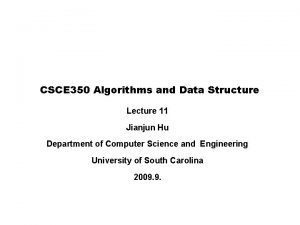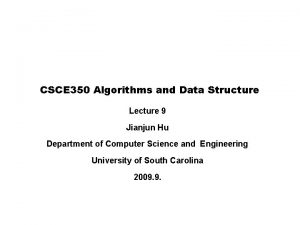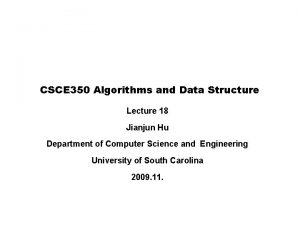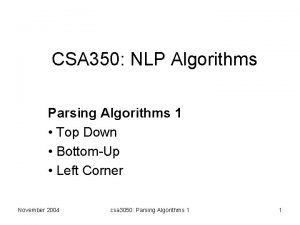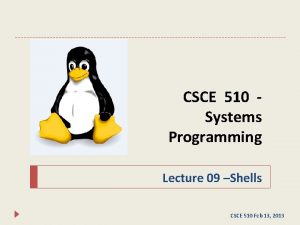CSCE 350 Algorithms and Data Structure Lecture 4



















- Slides: 19

CSCE 350 Algorithms and Data Structure Lecture 4 Jianjun Hu Department of Computer Science and Engineerintg University of South Carolina 2009. 9.

Outline q Review of last lecture q Properties of Asymptotic classes q Asymptotic classes of time/space complexity q How to analyze the Time Efficiency of non-recursive algorithms

Last Lecture: Theoretical Analysis of Time Efficiency Time efficiency is analyzed by determining the number of repetitions of the basic operation as a function of input size Basic operation: the operation that contributes most towards the running time of the algorithm. input size T(n) ≈ cop. C(n) running time execution time for basic operation Number of times basic operation is executed

Asymptotic Growth Rate A way of comparing functions that ignores constant factors and small input sizes O(g(n)): class of functions f(n) that grow no faster than g(n) Θ (g(n)): class of functions f(n) that grow at same rate as g(n) Ω(g(n)): class of functions f(n) that grow at least as fast as g(n)

A Useful Property How about the growth order of

Basic Asymptotic Efficiency Classes 1 constant log n logarithmic n linear n log n n 2 quadratic n 3 cubic 2 n exponential n! factorial

You Should Know How to sort the different asymptotical efficiency functions, such as Exercise 2. 3. 5. A useful formula: Stirling’s formula

Analyze the Time Efficiency of An Algorithm Nonrecursive Algorithm Recursive Algorithm

Matrix Multipliacation

Time efficiency of Nonrecursive Algorithms Steps in mathematical analysis of nonrecursive algorithms: Decide on parameter n indicating input size Identify algorithm’s basic operation Determine worst, average, and best case for input of size n Set up summation for C(n) reflecting algorithm’s loop structure Simplify summation using standard formulas (see Appendix A)

Useful Formulas in Appendix A Make sure to be familiar with them Prove by Induction

Element Uniqueness Check whether all the elements in a given array are distinct Input: An array A[0…n-1] Output: Return “true” if all the elements in A are distinct and “false” otherwise

Selection sort

Insertion Sort

Insert Sorting—running time cases § The best case input is an array that is already sorted. In this case insertion sort has a linear running time (i. e. , O(n)). During each iteration, the first remaining element of the input is only compared with the right-most element of the sorted subsection of the array. § The worst case input is an array sorted in reverse order. In this case every iteration of the inner loop will scan and shift the entire sorted subsection of the array before inserting the next element. For this case insertion sort has a quadratic running time (i. e. , O(n 2)). § The average case is also quadratic, which makes insertion sort impractical for sorting large arrays. However, insertion sort is one of the fastest algorithms for sorting arrays containing fewer than ten elements.

Improvement of Insert sorting § Shell sort: two simple variants requiring O(n 3/2) and O(n 4/3) running time. § binary insertion sort § In 2004 Bender, Farach-Colton, and Mosteiro published a new variant of insertion sort called library sort or gapped insertion sort high probability in O(n log n) time

Example: Find the Number of Binary Digits in the Binary Representation of a Positive Decimal Integer

How to identify inefficiency and speed it up? What is it doing? Time complexity? How to speed it up?

How to identify inefficiency and speed it up? 2. 4. 7 Matrix multiplication For i 0 to n-1 do for j 0 to n-1 do C[i, j] 0 for k 0 to n-1 do C[i, j]+A[i, k]*B[k, j]
 Csce 350
Csce 350 Csce 350 tamu
Csce 350 tamu Csce 350
Csce 350 Analysis of algorithms lecture notes
Analysis of algorithms lecture notes Introduction to algorithms lecture notes
Introduction to algorithms lecture notes Static data structure
Static data structure 01:640:244 lecture notes - lecture 15: plat, idah, farad
01:640:244 lecture notes - lecture 15: plat, idah, farad Professor ajit diwan
Professor ajit diwan Cos 423 princeton
Cos 423 princeton Data structures and algorithms tutorial
Data structures and algorithms tutorial Information retrieval data structures and algorithms
Information retrieval data structures and algorithms Data structures and algorithms bits pilani
Data structures and algorithms bits pilani Data structures and algorithms iit bombay
Data structures and algorithms iit bombay Data structures and algorithms
Data structures and algorithms Data structures and algorithms
Data structures and algorithms Waterloo data structures and algorithms
Waterloo data structures and algorithms Signature file structure in information retrieval system
Signature file structure in information retrieval system Data structures and algorithms
Data structures and algorithms Stream data model
Stream data model Algorithms + data structures = programs
Algorithms + data structures = programs

